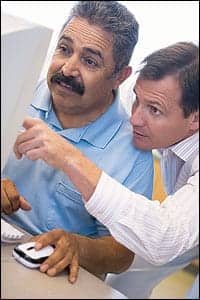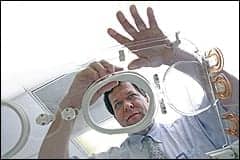The recent Healthcare Information and Management Systems Society (HIMSS) conference and further, the CE-IT Community—a collaboration between the Association for the Advancement of Medical Instrumentation (AAMI), the American College of Clinical Engineering (ACCE), and HIMSS—made us think that an article from a different perspective on the CE-IT convergence might be interesting.

With the CE-IT convergence gaining emphasis nationwide and many professional societies as well as health care facilities getting involved in working out cooperative arrangements, we thought that it would be interesting to get a perspective from BMET students—specifically, two Cincinnati State Technical and Community College students. These students have extensive co-operative education experience in the hospital environment.
A little background on the student’s program of study would also be helpful. The biomedical program at Cincinnati State is named Biomedical Equip-ment and Information Systems Technology. Its name was changed to that from Biomedical Electronics Engineering Technology in the 2001–2002 school year. The name of the program was somewhat controversial at the time since we knew that IT was coming to biomed, but it was not widespread yet. Well, it got here faster than we thought, and the program has proven to be a great source for training biomedical technicians. The program combines traditional electronics courses, biomedical instrumentation courses, computer networking, as well as math, science, communications, and humanities.
In addition to the classroom component, the program requires that the students alternate between five, 10-week school quarters and five, 10-week co-operative education assignments in a related biomedical field, usually a hospital. These two students have worked in the hospital for alternating 10-week terms for 2 years, and are a quarter away from graduating from Cincinnati State with an associate’s degree in Biomedical Equipment and Information Systems Technology. It is interesting to see that one of the students had extensive IT background and the other had virtually none prior to attending Cincinnati State. As you will see from their comments, they have had the opportunity to gain insight into this convergence. Here is what they have to say.
Joben Carter’s Perspective

At times, biomeds and IT get along about as well as the Hatfields and McCoys! Even so, one thing is becoming more and more evident: IT is an ever-increasing part of a biomed’s world. I experienced this firsthand during my experience as a biomed co-op. I had direct contact with the IT department, and I had to work side by side with them installing computers for the Epic system. The clinical engineering department was responsible for the mounting and computer hardware installation, while IT was responsible for the network and software parts of the installation. Due to mitigating circumstances, the IT department had to start helping with the hardware part of the installs. Thus, another co-op and I had to instruct the IT department on the installation procedure. This situation, among others, proved to me that IT is a big part of being a biomed.
My background does not include any IT experience whatsoever. Honestly, before going to Cincinnati State Technical and Community College I was just an Internet surfer that did not even use e-mail. Since I have taken two networking classes, I have a working knowledge of how networked systems operate. There are two network communication classes that are a required part of the Biomedical Equipment and Information Systems Technology program at the school. Students in the past did not even have the opportunity to take networking classes. My opportunity to work hand in hand with the IT department helped me greatly when I was required to take these classes. I felt like I had something to add to the classes, also.
During my co-op experience, I had the good fortune to work with a senior technician with over 20 years of experience. His main responsibility was the imaging equipment, during which he explained the health information management system and PACS to me. He even said his IT knowledge was mostly self taught since the networking classes did not even exist when he went to school. He said that students today have an advantage over some older technicians because the networking classes are part of the curriculum.
It is evident that networking is an integral part of being a biomed. It is part of patient monitoring, imaging, and many other areas. Biomeds have to work with and sometimes even for the IT department. Technology is always improving, and networking is an ever-increasing part of it. I believe as a biomed it is good to have an overview and basic understanding of networking systems. I feel that some form of IT should be a required part of any BMET curriculum. As mentioned, I did not have any IT background before college. I am confident that the networking knowledge I obtained at Cincinnati State will be very beneficial to me in the future.
Keith Witt’s Perspective

Choosing the Biomedical Equip-ment and Information Systems Technology program through Cincinnati State has been a wonderful and exciting career refinement for me. I describe entering the BMET program as a refinement because I had been working for a number of years as an IT professional and I felt that if IT wasn’t the present of BMET, it was certainly the future.
During my co-op experiences at Cincinnati Children’s Hospital Medical Center, I saw that IT experience is certainly going to be a major benefit, if not a requirement for newly minted biomeds. Many of the devices that I encountered could interface with a PC, and increasing numbers were networkable. Hospitals, I learned, are embracing new technology and using it to reduce costs and improve patient care and safety.
I think that it will be interesting, however, to see how biomed shops and IT shops learn to work together. Just because one knows about computers does not, in my opinion, qualify them to work on medical devices. Moreover, some biomed shops may find that it is beneficial to rely on the IT shop for infrastructure design, deployment, and maintenance. I feel that the sooner both teams learn to work together, the better the outcomes will be for the patients.
For these reasons, I appreciate the fact that the program at Cincinnati State consists of both traditional EET [electronics engineering technology] and BMET classes as well as information systems classes. Coming from a hardware IT background, the BMET program here seemed to be a natural and logical progression for my career, but I also can see that the addition of the information systems portion of the curriculum is in response to the changing demands on the biomeds of the future.
In my year of co-op, my IT experience certainly was a great resource. I found it helpful to know what to look for when a tech asked me to get a certain cable or how to set up a switch for rolling out defaults to a monitor. In addition, I spent a portion of my co-op doing computer installs while the hospital was preparing for an EPIC go live. During the installs, our team inspected the systems for damage due to wear and replaced items as necessary to prevent system downtime or even safety hazards.
Upon beginning my co-op opportunity, I expected to gain my largest sense of accomplishment by learning something new, fixing something—doing something technical. I was quite pleasantly surprised that this was not the case. I found the greatest sense of accomplishment in knowing that in a small way, I helped to make sure that a sick kid went home well. I believe that many biomeds find this to be the case as well—and this will not change no matter how biomed shops of the future change.
Observations
In conclusion (Yelton says), these students and our other students have embraced the study of IT in addition to traditional biomedical topics and have found the courses to be extremely informative. They have particularly enjoyed the study of the influence of IT on biomedical systems that they encounter in their biomedical instrumentation courses.
|
Read previous Networking articles in past issues in the 24×7 archives. |
Students who are new to the biomedical field are not at all threatened with the IT courses, and the existing biomedical technicians that are returning to college for IT training have transitioned very well into the courses. The biomedical technicians are accustomed to working with very technical problems and have slowly been learning IT concepts in completing their duties as biomedical technicians. They have welcomed the opportunity to engage in structured IT courses and look forward to applying the concepts on a daily basis.
At Cincinnati State, we are currently seeing a huge influx of displaced workers, workers looking for additional skills, and midlife career changers due to the current economic conditions. These students tend to be nontraditional, older students. Returning to school alone is a very daunting endeavor to them, let alone trying to study IT, yet nearly every technical program includes IT in some form. I am happy to report that by the time that they are halfway through the first quarter of school, these students have already embraced this learning opportunity and are very excited about their new direction in life and are looking forward to an exciting new career.
Steven J. Yelton, PE, BSEE, AAS, is a department chair in the Center for Innovative Technologies at Cincinnati State Technical and Community College; and is a member of AAMI’s board of directors and the Technology Management Council Executive Committee. For more information, contact .





